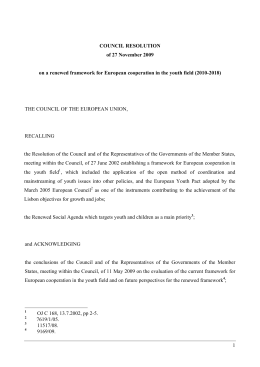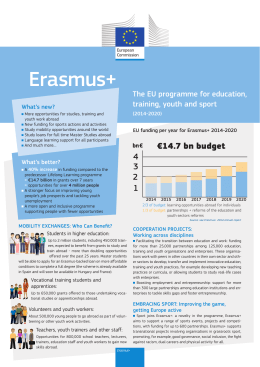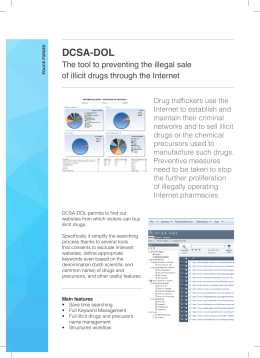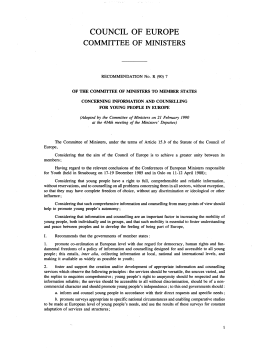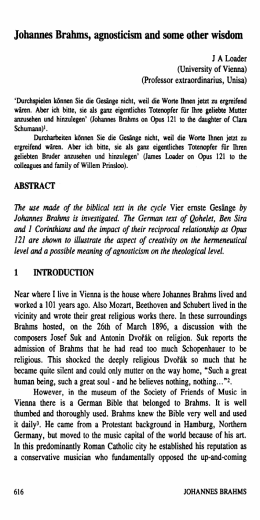W
'nes
Prmmting physical activity with older people
ACKNOWLEDGEMENTS
T h e H E A wishes t o thank the f d l o w l n g people for their support and advke i n the compilation
of t h i s document: Joyce Abbatt (commissioned author), Loraine Ashton ( H E A Adviser on
Older people), Alison Brookes, Kim Buxton, Mima Cattan, Adrian Coggins, Nikki Coghill,
Dianne Crone-Grant, L e s l i e Douglas, S u e Drew, Angela Gabb, DebraHall,
Phil Olding,
Fat O s b o r n e , K a t e Salmon, Kate Sheldon.
CONTENTS
Introduction
1
Who K this gmde for’?
2
Why is this guldc needed?
3
How should this gyude be used?
3
.Making the casefor promoting physical
activity with older people
2
3
4
1.I
What do we mew by older people’?
4
1.2
Why older people’?
4
1.3
What type of physical act]wty should be promoted?
6
Preparation for planning
2.1
The target audicncc
7
2.2
Overcoming barriers to participation
9
2.3
Key local pmtncr agcncles
2.4
Tmmmg
2.5
Principles of working with older people
2.6
Avadribdlty of funds
10
10
II
II
Working with other organisations
3.1
Developing a strategy
13
3.2
Promoting policy chrmgc
14
3.3
Stimukrtmg the actwitics of orgmsatlons
Is
Planning and implementing physicalactivity interventions
Objectives
16
4.2
Indicators
17
4.3
Choosing settings
17
4.4
4.5
TWCSof physical activity
Communication and publicity
18
4.I
18
Appendices
Appendm 1
Examples of initiatives
Appendix 2
Local agents and their potential contribution to the
Appendix 3
R<fermces
promcmon ot-physd
activity with okkr people
INTRODUCTION
Who
is this guide for?
This guide is aimed primarily at the statutory and voluntary sector and related agencies who arc currently
working with, or for, older people. They may or may not already be working in the area of physical activity.
They may directly provide, or have the potential to prowde opportunities for older people; or they may have
a more strategic co-ordinating role in working with these agencies which provide services or facilities. In
some cases. an individual or agency may have both providing and co-ordinating roles.
This guide highlights ways in which these indiwduals or agencies can encourage the promotion of physical
activity to contribute towards improvements in the health of people aged over 50.
Why is this guide needed?
This guide has been designed to help a range of people working at a local level who are planning ACTIVE
for LIFE activities that target older people aged 50+.
The promotion of physical activity is a rckitively new area with regard to the health needs of older people.
Consequently, those involved in promoting physical activity, and those working with older people may have
limited experience. traimng and resources to help them develop their work.
The .4CTWE for LIFE campaign provides an opportunity to take forward work with older people as a
result of:
●
thedewlopnwnt
of the new plysicul
uctivi(v fh-e tinm
activi(~’ message —that thirty minutes of moderate intensi(~s
a week will bring .wgnificant health benefits – a realistic
and appropriate
message to take to older people
“ a 3-.vear campaign which jhcuses on older people as a spec(fic tatget group
9 graving
unweness
of demographic changes in socie(j” and the economic consequences
ofa Iatge,
increasing!v inactive, proportion qf the popuh.mon.
Ncw approaches, new partners and new settings will need to be found at local level in order to encourage
older people to participate. This guide aims to assist this process by:
●
making the case, fiw pramoting physical activi(v ~rith older people
●
sldggesting methods oj warking
“ describing example.v. fmn practice
“ pmvitiing information about available resources.
How should this guide be used?
You may read the whole of this guide or select those areas which are appropriate to your current situation.
Some suggestions are made below.
“ Winning resources and support Younla~-n“ish10 argue tiw casejbr nen”or additlanal resources
for promotingphysical
activi~.ibr ollierpeople. The relevant data is primari!v in Section One.
●
Considering the issues BeJ.m you decide what initiatives to implement, -VW ma>’wish to consider
briefly sotne qfthe key issues surroutuiing the area oj’plysical artivi[v and olderpeople,
The relevant
data Mprimuri!~s in Section Tit-o.
●
Developing or expanding local strategies Youmu-v wish to develop u strategy in your laculity
ii’hieh co-ordinates the work qf other agencies. groups and indwiduals M“ithan interest in the health
ofalder peaple. Section Three highlights some of “these issues.
9 Planning single, small intewentions
Youma-v wish to inlplement u sin@.
stnaller intervention.
Section Four provide.v u planning fiameMYwh-jorthis.
“ Finding out about resources, projects, national programmed
exatnple.s oj’practice
(Appendix One) and a more detailed list
The appendices
contain
of Iocul agencies and orgunisations
who could pla.v u part in and support )’our activities (Appendi.v TJVO).
This guide should bc used in conjunction with other .4CTIVE for LTFEcampaign documents. including the
campaign resource pack, the Agencies guide and the Action Pack.
,,‘
Section
MAKING
one
THE CASE FOR
ACTIVITY
WITH
1. What
PROMOTING
PHYSICAL
OLDER
PEOPLE
do we mean by older people?
Traditionally older people were defined m those of retirement age or more. This definition has become too
resrncted in the face of changing work patterns and the growing appreciation of the benefits of physical
actiwty taken earlier in older Iifc. As a means of examining the needs of older people, the ACTWE for LIFE
campaign and this guide define ‘older’ as anyone over the age of 50 years. The age of 50 is a point at which
the benefits of taking regular moderate physical activity become incretisingly important in avoiding,
reducing or reversing much of the physical, psychological and social deterioration which often
accompanies advancing age. ‘“Thesebeneficial effects apply to most individuals regardless of health status
andor disease state”’(World Health Organisation 1996).
1.2 Why
older
people?
It is true that most people would benefit horn increased activity levels. so why focus on older people?
●
We
have an ageing population
T}w pmportiw
of older people in the populutio}~ is increasing
rapid!~: particular!v those over 85. In a [}pical district.
3(Eo
of the population
is like!v to be over the
age af 50. By the year 2000, people ageti 45 and over nvil amount Ihr 50°fi qf ‘the population.
oj”this age group alone argues that uttention shouhi be puid 10 their pllywcal actn’i~. needs.
4
The size
●
Older
people
are less active
“ Three out af ten men (33%) undjour out of “ten~tww
(38%) aged hwtven
55 und 74-wars are
sedentarr (1.e. purtici~]ate in Ie,w than half an how qf moderate intensi!y plysicul
●
activi(v a week).
compuwd with about a quarter (23°4 qf men and 24% ~f women) of ’all adults (HE.4 19956).
29°% oj men umi about a ji/Ih qf women (2104), a~yd between 5.5 and 74 ?“ears particrj~ate in
recommended levels ojphysicai
activi(v (i.e. at least 30 minutes of moderate pjl~wical activi~ on at
least jive occasions u }t’eek), compared ti’ith tw’ojljihs (41 ‘4) of men and near!v a third ~?f’~~’omen
(32%) averall (HE.4 lW5h).
8 Eight out qf ten udults (77? 6 qf men and 80% @’ itwnen) u~yd behi’etw 55 and 74 years participate
in at least one 1-2 mile walk at atl.vpace in a four week period. Howeve~ on!v ahaut one.j~fth (2104
oj”men and lWJ af women), walked ut a pace ~t’hichwould benefit their health, (i.e. tiescribed their
~tulkingpace as either ‘fair!\’brisk or,fust ) (HEA 1995b).
.
Fitness levels are low
●
Almost one third of “men and mow than halj-qf”tcomen aged 55 to 74 >Seurs~t’ould.find tvalking at a
nortnal puce on level ground impossible to sus[uin (AIlied Dunbar Nutional Fitness Surve\S 1992).
9 Near!~’ a third (30? O)
Of
men and half oj’ i~mnen aged hcw’een 65 and 74 do not have sufficient
muscular strength around the thigh to rise easi!v.fiwn a lou” chair (Allied Dunbur National Fitness
Survey 1992).
9 Amangst women aged aver S5 ~“ears, on!~’haljhal ‘e sul]icienr leg poww to clitnb stairs easi!~’(AIlied
Dunbar Nutiwtal Fitness Survey 1992).
●
The potential
health
benefits
are substantial
.fhr both the individual and society. Promotion ojph)xical
The benejl[s of being actiiw are wb.wanrial
acti~i(v can pluy a signit;cant role in ~forts
to achieve Health qfthti Nution tatget.s in CHD reduction, us Mwilas accilient prei”ention und mental
heulth pmtnotion.
Keeping ph-~xical!~”active as we gmir older can help to ameliorate. or e~wl reverse, mat~y ~f the e(iects
qf ageing. Muscle strength, pww
endurance and. fle.rlbili(i’ decrease }t’i!hage, but maintaining health)”
levels qf uctivit>’ can help to reduce these declines (Young 1994). An active Iljiest>”lein adi~ancing.vears
has been jixmd to he beneficial in improving ~)lltscl[lar-.vkeletal Junction and strength ~t”hichin turn
helps prevent jhlls and tnaintain independencefiw
dai!v li~-ing (Blair 19921.
Pl!~wcal activi(j’ has an enormous range af’potential health benelits. many of which are particulatfv
relel’ant.for older people.
Plain physical health benefits Increaseli le~’elsofpl?wical
●
uctivit>. can assist in:
the reduction in risk oj’comnury heart disease und stroke
“ the prevention or control of high bload pressure
8 the prewn tion qf osteoporosis
w the impmrement @joint mabilih” and muscle streng!h
s bt”eightcontrol
“ the reduction in accidental. falls
●
improving kyneral cardiovascular.j itness andfimction
w the reduction in risk oj “diabetes (Ppe 11).
Reguhwphysicu[
activi(v
Fnqy
also help to reduce !he risk of cuncer of the colon
5
In addition to its physiological et~ects. participating in physical activity can have a number of important
effects in terms of psycho-social health, as well as broader effects on society.
Main psycho-social health benefits Purticlpation in physical activiy
by olderpeople
●
the improvement ofself:e.vteem and confidence
●
increased opportunities jbr socializing and reducing isolation und loneliness
can assist in:
“ increased capael ty to remain independent t
●
enhanced jeeling @ ‘\t”orth of ‘older people.
Main benefits for society Soclet.vcan al.~o benefitfiwn
a more active older population through:
. a reduction in demand on ilealth and sociul services
. more positive itnuges qj ‘older people and their value to socie(v
. increased contribution to .wcie~ and the econcwl.v b)’ oltier people.
1.3 What
type of physical activity should be promoted?
Jdeally. people should aim to take part in physical activity of a moderate intensity (like a brisk walk) for
half an hour, on five days of the week or more. This is the level that has been found to have significant
benefits to health (Moving On, 1994).
While this is the ideal recommendation, it should be borne in mind that any activity is better than none, and
people should be encouraged to start at a level of activity with which they arc comfortable. This may even
bc 10-15 minute bouts of activity to begin with. The greatest relative health gam comes from encouraging
a sedentary person to begin being a little more active. The key to achieving and maintaining a more active
lifestyle is for older people to participate in activities which they enjoy and which can easily be
incorporated into their lifestyle. Moderate activities such as brisk walking, swimming, social dancing.
climbmg stairs, cycling, heavy DIY, gardening or housework are ideal.
To benefit health, physical activity should be at an intensity that raises the heartrate sufficiently to leave the
individual breathing more heavily than usual, and feeling warmer. For people who have not been used to
activity. this could be achieved with walking at quite a slow pace, while for others it is usually more akin to
a brisk walk. A good test of intensity is the talk test. If you are too puffed to talk comfortably with someone
while being active. you arc probably doing more vigorous level activity, and should reduce the intensity.
Many older people may find even a 10minute walk beyond their functional ability. In such circumstances it
is more appropriate to encourage specific activities to help to improve mobility and muscular strength. This
type of exercise will ofien require specialist instruction and supervision from a trained practitioner (see
Section Two). Generally, as people grow older. joint mobility and muscle strengthening exercise becomes
increasingly important to maintain optimal functional capacity and avoid or reduce the physical
deterioration which is often associated with advancing years.
6
Promoltng
phl 311.ul dc,tlvtt>
——
wttli
older
pt, oplc
Section
PREPARATION
tww
FOR
PLANNING
Making a start
There are some key issues to consider before you plan what you can do to promote physical activity for
older people. Appropriate types of physical activity and the key messages are described in Section One.
Th]s section focuses on issues surrounding the target audience, training and the potential role of key
agencies and organisations.
2.1 The target audience
It will be helpful to define the physical activity and health needs of older people more closely in order to aid
the planning of activities. A range of variables relating to the needs of older people can be explored to help
plan and shape prograrnmes. Different approaches will be needed according to where the target population
lies along the following continua:
Active
Having a health problcm
interested
‘Young’old
Independent
Inactwe
No health problcm
Not interested
‘Old”old
Dependent on others
7
Promtatlng
ph.r.vtcul
uctIt
II.I
II 1111tIldLsr pLsoplr
Active or inactive?
Older people who arc currently active, regardless of age, need encouragement and information on
maintaining and/or increasing activity levels. Efforts at local Icvel could include:
●
ensurin~r that there is no loss of existing opportunitie.v
●
reassurance that there is public and projiwsional approval for older pwple
●
the encouragement t al-positive local media responses and image.~ of active older people.
continuing to participate
Regardless of age. those who are inactive need encouragement to increasetheir actwity levels through a
change m physical activity behaviour.
Specific health problem
or no specific health problem?
Older people with a specific health problem e.g. CHD. osteoporosis. stroke. obesity, will benefit from
interventions designed specifically to improve the]r condition or mmimise the impact of any disability.
For older people without a health problem, interventions can help to focus on the range of activities which
could help to protect against. or reduce the impact of. future health problems.
Interested
or not interested?
Older people will have differing levels of interest in participating in physical activity. This interest will be
shaped by a variety of factors including:
●
earlier experiences - mu-vhave shaped att itude.v to health, old a~zeand p)~yvicul activi(v
●
living environment
- ma.v be urban or rural, tower bloch-, house or residential acconunodation/
nursing home. Accommodation
can e~~ectaccess and individual ability with regard ta physical activit.v
8 gender - men and women hare d~ffimwt attitudes to ph-~xical activity particular& post-retirement
w ethnic origin and culture - d@went cultures huw di~”erse approaches to pll]”.sical activi(i’
“ self-image - nla)~y older people see getting older as part qf a natural decline in capaci(v und
increase in disabili(v
●
employment
-
in employment
or not emplqwd.
This may af]ict
ene~gj’ available.
8
P#onlnrlllg
ph.!
<I L.(JI ‘1’ rlvltl
——
M [Ill
Ulllt,r
pc[lplt
the amount of. time and
‘Young’ old or ‘Old’ old?
Initiates for the ‘young’ old may focus on Improving and maintaining cardiovascular health. For the bold”
old emphasis may be more appropriately placed on the maintenance of balance mobility and strength.
although cardiovascular health will still be important in sustaining fictional capacity.
Independent
or Dependent
on others?
Many people enjoy independence and mobility throughout their life. For others the number of ‘disability
free days” enjoyed in later life may decline and consequently the opportunity to be physically active may
require support from others such as family and carers.
2.2 Overcoming
barriers
to participation
Those planning activities and programmed will need to be aware of the many barriers older people can face
and seek ways of overcoming thcm:
●
poor knowledge of the benefits of physical activity Ohier people of)en ussociate pltysicai
acti~’ih”trith it’eig}u control hut ha w less knowledge ubout !he speciiic betwfits of moderate physical
activi(~; Their h-notl’ledge aboul the amount (?fphystcal uctiviy needed to trigger bene)its is al.ro low
●
attitudes of older people to physical activity.4 decline in plysicai
and social. functioning is
lutge!~. accepteti as inevltahle b!’ older people. Older people tend to he tnore concerned about a
decline in mental capaci~:
Remaining nlenlal!v uctive uml tnaurtuining a pasitil’e ou!loak is of
higher priori(v than inlp)~i-ing ph>xical cupacity.
“ attitudes and knowledge of professionals There nza>.be a lack ofawarene.rs amongst maiy of
those MS11O
n-d- ~~”ith
older people oj’the benefits (?fpurticipution in physical uctni(v b>”older people.
Furthec pmfessionul.s are ojien not a}tzzre ofcurrent
developments
concerning the iwalth issues of
older people.
●
access to people with skills and experience Health prafe.wionals
kno}~’ledge of the pllysialogicul
spec~fic e.rpwience and knowledge of pwmotmg
●
general!v have a basic
Iwnej?ts t?f”physicid acti~si(v but tnav be una~tsare of others ~t’ith
phwical activit.v hrith older people.
the negative image of old age Old age can he portrqved
us a time in l~fe to be jkared. Media
publici(l” ubout older people qjlen jbatures the relationship ben~twl age und the burden qf e.qculating
costv qfresidentiat
and nursing care. Picture.f of older people shivering be.~ide one bar of un electric
fire in Winter hale supported this negatil.ti inlage. The use ~fpositive images portraying older people
enguged in und enjq’ing p}!~xical ac!ivity is importunt.
w low awareness of active leisure opportunities More imaginative and appraptvate methods qf
marketing and promoting pll-vslcal activi(v to ohiw ptwple need to be explored in order to reach this
population
●
gro14p
and raise a}rarene.m of existing and ne~r opportunities.
older people and physical activity - on whose agenda? Tile HE.4 natianal cutnpaign ACTIVE
for LIFE und its promotional actnitie.s ptw’ilie an exciting opportuni(~” to mise the ptw~iie of the
ph>xicul ac!i~”i(vrelated health needv ofp.wple.
This ~~’illcontribute to~rards a greater understanding
and uhcareness. and ussist in gaining the \rider support ofpolicy
alder people thetn.wh’es.
9
Promoling
phtsI<ul
UCtII
It I wIrlI
t)lJet
pcIIple
nwkers, professionals,
tnedia and
2.3 Key local partner
agencies
At local level there area number of individuals. groups and organisations who have the potential to play a
part in the promotion of physical activity for older people. Whilst there are already examples of existing
working partnerships there is a need for local agencies to re-examine their potential for collaboration.
The people and arms with whom you can work ofien overlap in their remit and interest. The following may
be helpful in defining some of these areas and interests:
v w-kpkrws, occuputzonal health, pre-retirement groups. adult education can pm~ side access to target
●
groups inside and outside enlployrnent
_ environmental
agencies
can influence pravision
of sale physical uctiri~v em’ironments thraugh
ttrm.sport policies, mad sufi(v schetnes, convnumty planning
●
volttntary sectoc including net}i’ork graups of older people, ojjir direct contact \vitil the ta)get gruup
and an understanding
oj” their dlf..ering needs, as well as access ta local groups, otganisatians
unr.i venues
“
uccir.ien t prevention agencies — including social ser~’ices, prinla~y heulth care, voluntary.
sectoc trallnla clinics, transport and planning and tiw.se in health promotion with an interest M
preventing. fb[is
“ leisure, recreation und the.fitness indust<r ojj$eraccess to.facilititis and trained instructors and kuders
“ social services,
including curin~~and tnentul health set~ices. oj?er access m tile ttuget graup and
opportunitie.v for adapting contracts of cure
●
residential homes and sheltered accwnrnodatiun prowde opportunities jor one to one \rork
●
primary healrh care can identi~i’ those ~vithspecial needs anti those at risk and provide counseling
approaches
“ hospitul geriatric ~i.ards and nursing home.v can provide access to the tutget graup.
Appendi.v ThIolists local agencies anti their potential contribution to the pramotion (?fphwicul acrivi(v wth
okier people
2.4 Training
related
physical
to the teaching
activity
with
older
of health-related
people
The provision of appropriate training for all those involved in teaching physical activity to older
people is an essential feature of the planning and preparation phases of schemes and interventions.
There arc a limited range of courses run through different training providers – colleges, univmsmes,
commercial training organisations, local authorities and nat]onal governing bodies of sport. However this is
a relatively new area of development and co-ordinators will need to consider caretldly the relative
strengths, assessment procedures. certification as well as course content of the different schemes that are
currently available.
Some training courses that consider the needs of frail older people have been developed. Safety aspects and
appropriate activities for older people are essential components of such courses as well as the physiology
and psychology of exercise and how it relates to older people.
As an alternative to a college-based or national course, a local training course could be developed. This
might be one of the benefits arising from a district strategy.
Complementary organisations rniiy work together so that staff in the different organisations can learn fi-om
each other. For example. exercise class teachers. staff in swimming baths or sports facilities might work
with staff in residential homes or social services to share experiences.
Certainly new programmed of services or projects should not be introduced until the staff involved have
acquired the necessary skills and an understanding of the needs of older people.
2.5 Principles
of working
with
older
people
There arc some general principles such as equity and coherence which underpin work with any specific
target group. Besides applying these general principles. implementers and co-ordinators of physical activity
for older people need to:
. prwvde opportunitie.r Which cwnbine.fim and sociulising }~’ithpl!~sical octivlty. Initiatives aimed at
promoting pl!vsical activit>’jor older people are more lilie!v to he e@ctive and sustainable ij-ps~.chosociul needs are the primaiy focus
. in~’ol~volder people in the planning. inll]let~le~ltatic~t~
and evaluation of opportunities
. address the specjjicph~’sical activit>’ unil health needs need.f of the diflerent gwups u’ilhin the overall
tu~get group
. addre.w the political, social and economic barriers ?~”hichinjluence the capacto. ojolder
participate
people to
In phwical activi!y
2.6 Availability
of funds
Many of those seeking to provide programmed for older people will be working within a health or local
authority fmmework of commissioning and purchasing. Advice concerning the inclusion of physical
activity in this process is included in the HEA publication Promoting Phys]cal Activity – Guidance for
Commissioners. Purchasers and Providers (see Appendix Three).
Sources of funding may also be found from the budgets of the various statutory agencies within the locality.
Other sources include local and national industries, charities. the National Lottery, regeneration funds and
participants themselves.
Additional resources may WC]]be Identified t~om other areas. The range of potential partner agencies
outlined earlier in this sectIon illustrates the number of key local agencies with a potential interest in the
physical actiwty related health needs of older people who themselves may be able to identify additional
sources of funding.
II
P)onlorlngph.vslcul
——
uctIrIr
I I< :th
—
OIJC v IIC>IJPIC
Section
WORKING
WITH
three
OTHER
ORGANISATIONS
SectIons One and Two have discussed the background to the actions you might take to promote physical
actiwty amongst older people. Broadly you may act by working with and through other organisations or
you may work by influencing change by planning smaller, single interventions.
This Section discusses the first approach whilst Section Four explains how you may plan and implement
physical activity interventions.
It 1sclear that many organisations are, or potentially could be, involved in promoting physical activity with
older people. These organisations should work in co-oniinatcd and complementary ways in order to
maximise the benefit resulting from their work. This Section explains three main ways in which you might
work with a range of orgamsations. These are:
●
developing a [aca[ strategy e.g. pllyica[
aciii’i(v or uccldent preven tion
“ promating policy changes e.g. transport. leisure
“ stinuda~in~~the ucti vities qf otganisations
e.g the Iocul brunch et-a voluntay
12
sectar o~anisation.
3. I Developing
a strategy
The purpose and advantage of developing a strategy for promoting physical activity with older people Mto
mobdise resources and to ensure co-ordination of the many organisations which can work in this area.
An effectively Implemented local strategy will lead to:
“ ofganisatiom being aware of “theunique and important mle that they can plu~”in pwtnoting pl~]’sical
actiw(v.jor older people
●
jiw’er gupb m the pravision aj”sert”ice.s or activities, Ie.w ol’erlap in such pravision and more
important!}; .greutw cohesion and continuity brh~’een this prwwion jbr older peaplc
9 clearer priorities and tatgets twt ‘ards which all relevant organ isutians cun n’ork
“ .sytetnatic evaluation of progress and a revie~t’of bane resaurces cun be used most eflectil’e!v.
A strategy will normally apply to a gcogmphic or administrative area. The strategy will intluence the work
of the various organisations whose work affects the physical activity habits of older people living in that
area. Therefore it is appropriate for representatives of these orgiinisations to prepare the strateb~. lt maybe
useful for these organisations to form an alliance which has the rcsponsibi]ity of formulating and then
supporting the agreed strategy. Ideally. older people themselves will play an important part in the
development of such a strategy.
What should a strategy include?
The strategy will be defined in a strategy document. There are no fixed rules for what this document should
include. but it will be useful to consider inclusion of the following:
●
the
a statenwnt of
rationale
8 u sunnnu<\I of”the potent[al
benejit.r uf-physical activi(v [o the health @ older people
bused on
research findings
●
a sunvna<v of the particular benefits f~~rolder peaple in the localip using el’idence und infortnatlon
fhxn 10CUIresearch
w a sunmaty
of the relevance and importance of the pranwtion ofphysiud
uctivi(v. for older people. for
euch ojthe partner agencies involved
●
a sunlnla~v ofnatlonal guidelines
9 a stutetnent
of principle.v ~ilich should underpin the strategy (when work-ing with older people)
8 a tie.scription of the aims und ob jective.~ aj’the strateg). ~tllich are specljic and measurable
●
an implementation plan including an indication of the timewale required
“ u list of ‘partners and contact uddresses
9 a glossa<v ofternls used und Aev references.
E.ratnples qi ‘strutegie~ are included in Appendi.r One.
A more detailed consideration of the process of stmtegic development to increase physical activity is
included in the HEA publication ‘Promoting Physical Activity – Guidance for Commissioners. Purchasers
and Providers’ (see Appendix Three). This document also includes information on effective monitoring.
review and evaluation of projects and initiatives.
13
3.2 Promoting
policy
change
The extent to which older people engage m physical activity can be influenced by the policies of a whole
range of organisations – some of which may have no direct remit for physical activity or direct involvement
with older people. For example. local transport policies may strongly influence the extent to which older
people can have access to facilities for physical actiwty.
Therefore. it is Important that policles are influenced shaped and adapted wherever feasible. so that they
can support physical activity for older people.
.
Examples of policies where change may be appropriate
●
local health policies - ure ph?tvicul at’tivity progratnmm jbr older people
pravided?
canvnissioned
and
Planning, housing and envitwntnental policies – are the physical activi(v needs Q/-older
people taken into account by pmwision qf appropriate facilities
with safi ucce,ss?
transport policies - is cwse of “access .fin- older people considered?
Ieisu re and sports policies - is participation acces.wble, aflbrduble and encouraged?
social Sewices policies- k thep~wmotion ojph-~xical uctivi(y incorporated into cantracts oj”care
in residential and nursing acconnnodution ?
hospital policies - is there a structured link between geriatric wards, tramnu clinics. pilysiotherap.1’
departments etc. and conununip providers ta support continuing pit>’sicul activi(v?
private
residential
and
nursing
home
policies -
are older
residents
encouraged
or
di.~cotouged to take part in regulur p}{~wical activiq”?
sports and private fitness clubs - are okier people
turge[ed and encouraged
to participate
e.g. through pn.wision of senior classes, vetemizs Ayoups or sections?
local media policies - arepmitive
images of older people pmmated in the local pre.m on the radio
and TV?
primary health care policies - IS there a structured link between GPs and prima t>’ health cure
teams ta supporl older people 10 imjwove their levels qfph-~’sical uclivi(l.?
How can you encourage
policy change?
There is probably rather little that an individual can do to change the policies of organisations. However, if
there is some kind of strategy document or alliance of concerned organisations which advocates policy
change. then a request to change or adapt carries much greater authority.
An example of how a group of concerned organisations was able to to intluence the residential homes
inspection pollcies of a Social Services Department is provided by Shuttleworth. Bedfordshire and
included in Appendix One.
14
P, ,>n,,>t,,,g
phb,l[
,11 ,,ctll
——
II)
wtrh
I)]dL-t
pe.llplt>
.I
Evaluating policy change
Evaluation of policy change primarily involves finding out whether the policies of the various organisations
have in fact changed. This part of the evaluation leads to decisions about where priorities lie for advocacy
with organisations which have not changed their policies.
The second aspect is to evaluate the impact of the policy change. This is much more ditl’icult. Usually it
WII1be the role of the organisations which have changed their policies to obtain the relevant data and
reach decisions. However, it may be useful for an alliance or other partnership to enquire whether the
organisations have such data and are willing to make it available.
3.3 Stimulating
the activities
of organisations
A flu’ther way of working with organisations is by stimulating them to undertake new activities that will
promote physical activity with older people.
This stimulation can be done in the following ways:
“ orgunisutiom ~i.hich ure prinlari!v concerned n“ith physical activity can be encouraged to extend
their work [o include older people
●
organisations
which are pritnari!v concerned
~vith older people
can be encauruged
m include
promotion ofplzysicul actil’i(r m their activities antiprogranune,s
8 appropriate
training can he o{jbred jor the stuflof these organisations
so that they have the skills
needed in their expanded progranune.v of }ivwk
w organ isutiom can be invited to join alliances or purinerships Jw promoting pl~mical uctivity ~rith
older people. This may include joint!l’ preparing propmols fbr.jitnding an evpani.ied range ofservices
or-facilities, or tistablishing an ohier peoples’ health fimm.
An example. promoting “Flcxercisc for Fun” describes how training and equipment was offered as a means
of increasing opportunities for physical activity for older people and is included in Appendix One.
One particular group of organisations which might bc stimulated is the local media. The aim would bc to
encourage thcm to promote a more positive and active Image of older people and to be less ageist by
refraining from including the age of people in their reports. You could do this by inviting them to events,
scndmg regular press releases and advertising on local radio and in local papers. Additional information on
working with the media is included in the ‘Action Pack’ in the ACTIVE for LIFE campaign pack.
.
PLANNING
AND IMPLEMENTING
PHYSICAL
ACTIVITY
INTERVENTIONS
This sect]on is intended as a guide to the ways in which organisations and individuals could adjust their plans
and programmed to promote physical activity with older people. The kinds of organisations considered are
those which directly implement services or provide facilities for physical activity for older people. The
organisations may be statutory agencies, private sector agcncles, charities or smaller scale self-help groups.
These organisations may respond to the needs of older people by adapting or expanding existing services
or programmed of work which continue indefinitely. Alternatively, they may introduce new projects
or pilot schemes.
Whichever type of organisation is involved the issues below should be considered.
4. I Objectives
The starting point for a project, or a change to a contlnumg programme. is to decide on the objectives of the
project or change. This will involve defining the types and number of older people who will bc affected and
the type of physical actiwity in which they will engage. The objectives may also state the anticipated health
or SOCM1
benefit which the physical actiwty can bc expected to yield.
Objectives should be consistent with any local strategy for physical activity. and should complement the
objectives of other organisations in the locality. They should also be consistent with the remit and purpose
of the organisation concerned.
4.2
Indicators
An indicator is rather like a road sign which shows whether you are on the right road. how far you have
travelled and how far you still have to go to reach your destination or objective. Indicators are essentially a
restatement of the objectives (or some aspect of the objectives) in easily measurable terms.
There are many kinds of indicators. indicators relevant to programmed to increase physical activity levels are:
w indicators of availability -. for .a-umple. the number qf opportunities .ftir regular plz>”sical uctivity
available
●
indicators of accessibility-these sho)t” whether ~t’hutexists (e.g. s~t’inuningpools, walks and open
space.~) is uctual!l’ ~t’ithinreach of “those JtAu need it
“ indicators of utilisation - these sho}t’ whether sonlethlng that ilas been made uvuilable is being
used /br that purpose, e.g. Pussport to Leisure Scheines.fijr Older Peuple
●
indicators of coverage - these show whut proportion
of tho.w+who could benejit.finnl something
are receiving it, e.g. people recei~’ing rehabilitation post stroke
●
indicators of quality - these .dloJr the qualqv or standurd of something,
qualljie(i stu{fenguged
e.g. the number qf
in conducting pilvsicul activiv sessions.
4.3 Choosing
settings
A setting is a point of access to people as well as a place where initiatives can take place. Initiatives to
promote physical activity will be able to utilise some existing settings but there will also be a need to
be imaginative and develop new ways to reach older people. e.g. through local voluntary sector and
community groups.
Existing
settings
“ prinuny health cure
●
ct~)tlftllttlip-ba.sed (e.g. halls. school facilities)
●
Iocul enwromnent (walks, c-}’clepaths)
w sports and leisure-facilities.
New settings
“ residential/nursing
lu.mes, day care cen tres, sheltered acconunodation/hosp
itals(truuma chn its,
plly.viotherapv und occupational thempv departments, ~~wrds)
●
the home
9 Mwvlplace jiw pre-retirement
educution and po.st-retirenlent
9 garden centres
“ churches, temples
●
local club.~. e.g. bw’1.v, carpet bowl.f
●
private. fitness facilities
●
curers ‘g?wup.s.
14w
of “social und sports futilities
Key criteria for determining
1sthe
setting=
setting:
●
acceptable to older people.9
●
accessible ta older people?
9 a~]ordablejiv
older people?
w sajiJfor older people?
4.4 Types
of physical
activity
For older people. careful thought is needed to select the most appropriate types of physical activity (see
Section One). Activities such as regular brisk walklng and swimming as well as more conventional sports
and recreational activities are certainly appropriate for many older people who are already actwe. Other
groups of older people may benefit from different kinds of physical activity. For example, physical activity
may be added to existing popular activities which are primarily social. or specit’ic programmcs designed for
those with particular and special needs.
.
Appropriate activities are those which:
●
meet the specific needs of older people. These should be planned in close consultation u’i[h
older people themselves, perilaps begin \i’ith a.fbcus on sociaVmental
health, or specific health
conditions.
●
take account of the current physical activity recommendations
current recommendation
for older people. The
of 5 x 30 minutes per }t’eek of moderate activi!v mu-vneed to be tailored to
meet the capabilitie.~ qfthe tai~~etgtwup. In tuidltion activitie.f might include spec(jic strength and
mahili(v exercise where appropriate.
●
take place in a “safe” and supportive environment. .4part.from minimizing a~y risks of
I
pl!vsical injuty. the environment must pravitie older people ~ith confidence and a}witi.fielings
embarrassment.
oj-
Some activities \vill also require appropriate and saj.? supel~ision.
4.5 Communication
and publicity
The objective of the programme or project may be to increase awareness of the benefits of physical activity
and to encourage older people to independently increase their levels of physical activity. Alternatively.
communication and public]ty may be used to increase awareness of specific opportumties, facilities and
activities that already exist for older people.
In either case the channels of communication used should be those which older people already use. These
channels can be determined by talking with older people and will probably include:
. local papers, maguzine.s and radio. pensioners ne~tsletters
●
Iocalpuhlic
✎
places o~wark
transport
●
shop windows and local pharmacies
✎
local promotional
el’ents
✎
health care and social service projtissionals - wgeries
●
local hbrarie.~. DSS ofices and Post Ojjices
●
vohmtan
✎
talking }vithji-iends, jiwnily carers and neigilbour.s.
otganisations,
pre-retirement
and health centre.f
groups and social clubs
Examples of initiatives promoting
Examples
of physical activity
“Get Active in Bedfordshire”
MK402AW.
physical activity for older people
strategies
Contacc Health Promotion Agency, Gilbert Hitchcock House, 2 I Klmbolton Rosd, Bedford,
Tek 01234355122.
“Take Part in Herts” Conract
Hercfordshire
Health Promotion, Gate House, Fretherne Road, Welwyn
Garden CIcy,
Hercfordshire. ALE 6RD. Tel: 01707390865.
Example
North
of an Accident
Tyneside
Prevention
and Newcastle
Contain
Strategy
for Older
Mirna Catran, Health Promotion
People
Departmerm
Unit 21, Alblon House, Albion
Road, North Shields, NE29 ODW. Tel: 019 I 2964479.
“1 Shall Wear
Purple”
- a one day conference,
Shuttleworth,
Bedfordshire
190 people attended a conference to discover new ways in which residential care. nursing homes and
sheltered accommodation can create an environment which provides opportunities for residents to make
more stimulating use of leisure time, including participation in physical activity.
The Conference Report made eight recommendations to the Joint Plaming Team for older people and
a major outcome was the proposed monitoring of provision of activity. The Assistant Director, Direct
Services, responded ‘bWhilstsome Officers-in-Charge have tried to ensure a range of activities is available.
others have not. I think it is a very practical idea that the inspection board are asked to include activities
in their inspection reports and I am sure this will help us identify more clearly those homes that are
falling behind.”
Details from: Pat Osborn, Health Promotion Specialist - Older People, Beds. Health Promooon Agency, Gilbert Hmchcock
House, 2 I Klmbokon Road, Bedford. MK402AW.
Project:
Flexercise
Tel: 01234792054.
for Fun, Somerset
This project. run and fimded by Mendip District Council, alms to provide elderly people in nursing,
residential. sheltered and day care centres with the opportunity to participate in physical activity. More
specificallyy, the project provides workshops to tram carers to become activity leaders and provides support
to establish “Flexercise’”sessions for elderly people in the different settings.
The whole initiative is fice for participants. In addition there is free loan of equipment and free on-going
support. workshops and seminars.
The project started with a pdot phase in 1993. moved on to Phase I ( 1994-96) for fwe towns and is
currently in Phase 2 with follow-up and fmdmg of new contacts. Approximately 25 homes regularly do
“Flexercise” sessions with 250 elderly people participating.
Lessons learned so far include the need to provide on-going support to homes such as visits. workshops
and networking. Further. using equipment and making it fun are important for motivating the elderly.
Details from: Diane Crone-Grant,
Leisure Health Promotion Officer, Mendip Dlstnct Council, Cannards Grave Road,
Shepcon Mallet, Somerset. Tel: 01749343399.
Project:
Accident
Prevention,
Exercise
and Older
People
In North Tyneside. a multi-disciplinary Accident PreventIon Group for Older People was established in
1994 with the aims of identifying and implementing programmcs to reduce mortahty and morbidity from
accidental injury and developing a joint accident prevention strategy.
The first step was to conduct a survey of reported and unreported accidents involving a cross section of the
population over 65 in North Tyneside bctwccn 27th October and November 6th. 1994. Over 80% of the
reported accidents were falls. The results of that survey formed the basis for the Accident Prevention and
Older People Seminar in May. 1995.
The Seminar proposed a 12 month excrcisc programmc for older people in Howdon Community Ccntrc to
bc conducted by an LAY tutor. The programmc started in April, 1996 and will run until March. 1997.
Funding of approximately f6.700 comes from City Challenge Funds and NewCdst]c and North Tyncside
Health Authority. Partners in the initiative are the Hdahh Promotion Department, Healthy Hearts (North
Tyneside), Howdon Community Centre and North Tyneside Pensioners’ Association.
It is too soon to draw on any lessons Ieamcd but a mid-term review and report will be available in October.
1996.
Details from: Mima Cattan, Health Promotion
Departmen&
Alblon House, Albion Road, North Shields, NE29 ODW.
Umt21,
Tel: 019 I 2964479.
Project:
North
Accident
Tyneside
Prevention
Strategy
for Older
People,
and Newcastle
One of the aims of the Accident Prevention Group for Older People was the development of an Accident
Prevention Strategy. This development is currently taking place and involves a wide variety of partners –
Health Promotion Department. Local Authority. North Tyncside Health Care (Healthy Hearts and Elderly
Services), Age Concern. Alzheimers Disease Society, the Pensioners” Association, Health Authority,
older volunteers.
The drafl of the strategy is not due until October. 1996. However. some lessons have already been learned.
Firstly, it is important to create and build on activities whilst developing a strategy; and secondly. it is
crucial that older people are involved.
Documents currently available are: a survey of exercise provision, programmc outline. conference report.
accident survey report
Details from: Ian Miller (HP Oficer),
NE29 ODW
Tel: 019 I 2232830
Project:
Ageing
Health Promotion
Department.
Unit21,
Alblon House, Albion Road, North Shields,
,.
.
Well
Lifestyle,
Devon
Since autumn 1993 Age Concern. Devon, has used Senior Health Mentors to help meet the needs of lonely.
isolated or depressed older people living in rural areas of east Devon. The Mentors refer older people.
especially bereaved and single older pecsplc, to opportunities for social interaction and exercise: provide
information and advice through a weekly pop-in: encourage healthy eating at various luncheon clubs and
restaurants and offer a befriending serwce.
20
Pr#lm,,[lng
p/1) .\f< Ml ‘1’ rIvIt.1.
..—
b%
1(/1 tlfcf t.) plwpft,
*
.-
..-
Funding was obtrained for this 3 year pilot project from the Department of Health and Age Concern,
England. Other sponsorship has come from HEA, P.P.P.Ltd., Merck. Sharp and Dohmc. Further funding to
operate on a part-time basis has been received from Littlewoods Lotteries.
Main lesson lemncd is the need to evaluate continuously to ensure that needs are being met.
An evaluation report is available at !25.00.
Details from
Project:
Ann Palmer, Project Manager, Age Concern, 44 The Quay,
Prime
Time
Club,
West
Exeter, Devon, EX24AN.
Tel: 0139250085.
Cumbria
This project has been running since 1992 and aims to encourage the over 50s to be physically active
through provision of information and identification ot’ a range of physical activity opportunities at a
reasonable cost. The project operates in sports centres in Allerdale and Copekmd in West Cumbria.
Organisations involved in running the project are Age Concern (North West Cumbria), Copehmd Borough
Council, Allerdale District Council and North Cumbria Health Development Unit.
The initiative has led to increased usage of the sports centres as well as the development of new groups for
walking and cycling. Age Concern has held an Active for Life briefing session for all its club leaders.
Lessons learned include the importance of creating ownership of the initiative by involving others; the
benefits of building on what already exists locally i.e. leisure and community centre activities and the need
to establish at an early date who wilI take administrative responsibility.
Details from
Elaine Tudor,
Health Dept.
Workington
Infirmary, Infirmary Road, Workington,
Cumbrla, CA 14 2UN.
Tel: 01900602244.
Project:
Frame
of Mind,
Bedfordshire
This project started in 1993 and aims to promote physical activity in older people as fun. social events as
well as contribute towards the Implementation of the Bedfordshire Accident Prevention Strategy and the
Bedfordshire Get Active Policy.
The project is peer-group led and currently consists of 60 men and women attending for limbering. line, tap
and creative dance. Extra incentive is engendered by the groups giving shows in the community at public
events and in club, hospital and resident Ial homes settings. There were 10 shows given in 1995.
Frame of Mind groups have built up a county-wldc reputation for excellent performances and the project
has resulted in an increase in membership and number of groups; self-reported improved social contact,
well-bemg and sense of purpose. A “’video”’history shows improved mobility and balance in members.
Details from: Patricia Osborn,
Health Promotion Specialist - Older People, Beds. Health Promotion Agency,
Gilbert Hkchcock House, 2 I Klmbolton Road, Bedford,MK402AW.
Project:
Fear of Falling,
The effect of a Mobility
North
Programme
Tel. 01234327427
ext 3466.
Wiltshire
on Perceived
Health
and Fear of Falling.
This project looked at the effect of a mobihty programrne on the perceived physical. emotional and social
health status of older people and the risk of and fear of falling, both inside and outside the home. It targeted
men and women between the ages of 65-80 years.
Details from Nikki Coghill, Senior Health Promotion Specialls~ Bath Health Promotion Umt. Bath NHS House, Newbridge
MIII, Bath, 8A I 3QE Tel: 01225825680.
Project:
Wealden
Vintage
Sports,
East Sussex
The aim of this scheme is to encourage physical activity with people 60+, promoting preventative health
measures with older people being involved in the planning and development. A survey of residents in
Wealden (East Sussex) sheltered accommodation, identified an interest in activities such as short mat
bowls, EXTEND exercise, indoor golf, and organised swimming trips. As a result. activities are being set
up in 23 sheltered housing complexes.
The scheme is coordinated by a volunteer and extended through a modified schcmc within the CCPR
Community Sports Leaders Award.for other volunteers from sheltered housing who will then promote and
develop the project.
The project rcceivcd initial funding from Wealden District Council. the local Health Authority and support
from Age Concern East Sussex.
Details from Stephanie Wadlow,
TN6
IDH.TekO1323443263,
Wealden
District
Council, Council House, Pme Grove,
and Katie Salmon, Health Promotion Department.
Crowborough,
East Sussex.
East Sussex, Brighton&
Hove Health
Authormy, Avenue House, The Avenue, Eastbourne. East Sussex, BN2 I 3XY. Tel. 01323430004.
Project:
Life on the move armchair
exercise
training,
Calderdale
The training scheme targets people working with elderly people who have limited mobility and operates
through Age Concern Day Centres and other centres providing sheltered housing accommodation in
Calderdale, West Yorkshire. The scheme is operated by a partnership between Calderdale leisure services,
Calderdale NHS Trust Physiotherapy department and Caldcrdale Health Promotion Unit.
To date, the scheme has trained over 60 people in a variety of community settings and the training is also
used in conjunction with LAY schemes.
Details from Louisa Homer,
HXI
2YT. Tel: 014223303B3
Leisure m Action, Leisure Serwces, Calderdale Sports Stadwm, The Shea Shaw Hill, Halifax,
./
-. . .
APPENDIX
Local agents and their
promotion
AREA
OF EXPERTISE
HEALTH
TWO
potential
of physical activity
contribution
for older
to the
people
AGENT/AGENCY
POTENTIAL
District Health Authority
Commissions/purchases
CONTRIBUTION
Family Health Services Authority
which promote physical actwmy
programmes and serwces
(Or combmed as a Health Commission)
.
DHA
Assessesneeds for the promotion
D[rector of Public Health
acuv[ty, selecting appropriate measures
of physical
DHA
Commlsslons programmes and services which promote
Speciahst in Health Promotion or
physical actiwty
Health Promotion Purchasing Manager
Momtors and reviews prowsion
FHSA
Enables and audns GP physical activity schemes
Primary Health Care Fackator
e.g. exercise prescription
General Practice
Developslparuclpatesin
(GP/Practice
GP counsellingladwce schemes
Nurse)
GP Referral Schemes
Direct health centre provmon
Data collection on patients’ physical actiwty
Cardiac stroke and rehabilitation mcorporatmg
NHS Acute Hospital Trust
or
I
DirectlyManaged
Umt
phymcal activity
Services Trust
Prescription of phymcal activity for mental health/stress problems
Progfammes to prevent osteoporosis
Hospital Consultant
NHS Community
I
or Directly Managed Unit
Consultant Psychiatrist
DHA or NHS Community
Health promouon
strategylprogrammes
Manager/OiTicer
Counseling and adwceto famdiesand htdwlduals-
NHS Acute and Community
I
SPORTS
I
Co-ordination and implementationof localphysicalactivitypromouon
Trust
or Directly Managed Unit
I
AND
LEISURE
Trusts or Directly Managed Unit
referral schemes
I
Health vmtor/comrnunlty
General health educatton to pauertts including health education
I
nurse/physiotherapmt
on physical acuvmy
I
Local Authority
Facilities.parks,sports and recreation promotion. events.training&
-
Leisure Services
Ieadershlp,use of commumty halls; play schemes sports development
I
programmed: reformation
Community facilities
Schools
Local Sporta (Advisory)
Sports Leadershipschemes/CoachmgAwards; network and association
council
of local clubs;festivalsand promouons
I
Local sports clubs
Provisionof f%cdltle%
new opportumtle$ trammgof leadersand coaches
Commercial
Focusfor trammg& competitions;accessm facilities,new OpPOrtunltles
Leisure Services
I
for paruclpation
SOCIAL
CARE
County Council or Metropolitan
Authority
Provisionof socialserwcesand care packages
Social Services
Voluntary
EDUCATIONI
INFORMATION
AND
Identifyingneed of groups with special needs, advocacy and provmon
Salvation Army etc.
of access to groups
Libraries
Prowsionand displayof Information
Further
Education collegee/Universities
Occupational
WORKPLACE
LAW
sector
Age concern, MIND. Women’s Institutes.
ORDER
Safety,accidentprevention, rehabilitation:accessto pmon
Police
recreationalFacihuesby public
Prison Service
.
I ENVIRONMENT
Fachtlesand clubs,trainingcourses
Fitnesstesting,Spotm and SocialClubs. pre-retirernent classes
health service
County Council Transport
Ttansport and Environmental Policy
and
and Highways Department
Cycle paths, Iightmg and safety, traffic calmmg and management
Local Authority
schemes play areas, access to countryside, pubhc open space, public
Planning Department
paths, rights of way, planning gain; pocket parks, urban parks.
Housing Departments
Local Authority
Environmental
Health
Voluntary
and independent
Health and safety, health education
Lobbying for, development and maintenance of conducwe
Home Safety Departments
organisations
environments- cyclewaysand footpaths,open spaces
and groups
, MEDIA
Local press and radio
Pubkcl% promotion of positiveImageof older person; developmentof home-
Older people themselves
Accessto groups and mdivldualsknowledgeof preferences
based activities wa radio
I LOCAL
KNOWLEDGE
1
!
---
APPENDIX
THREE
References
Allied Dunbar National Fitness Survey (1992). Sports Council and Health Education Authority. London:
Health Education Authority
Blair, S.N. et al ( 1992). How much Physical Activity is good for health? Annual Revimr oj’Public Healtit
13:92-126
.
Moving On (1994). International perspectives on promoting physical activity. London: Health Education
Authority
HEA ( 1995a). Promoting Ph-vsicalActivi(v – Guidance.fir
London: Health Education Authority
Comnnssions Purchasers and Praviders
HEA ( 1995b). Physical Activity Panel Survey. Health Education Authority (unpublished). London: Health
Education Authority
World Health Organisation ( 1996). The Heidelberg Guidelines for Promoting Physical Actwity among
Older Persons (final draft – unpublished). World Health Organisation: Geneva Switzerland
Young, A., Dinan. S. ( 1994). Fitness for Older People. British Metiical .Journal 309; 331-34
I
..
@a
F+'
'4z
'
HEAL7
0
Hmlth Education Authority
Hmilton H o w Mabhion Place h
n
d
mWClH 9TX
Scarica

